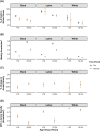School closures significantly reduced arrests of black and latinx urban youth
- PMID: 37494297
- PMCID: PMC10370768
- DOI: 10.1371/journal.pone.0287701
School closures significantly reduced arrests of black and latinx urban youth
Abstract
Background & methods: Youth of color are surveilled and arrested by police at higher rates than their White peers, contributing to racial inequities across the life course and in population health. Previous research points to schools as an increasingly relevant site for youth criminalization, but existing studies emphasize within-school mechanisms, with limited analysis of policing in surrounding school areas. To fill this gap, we study changes in police arrests of youth after initial COVID-19 school closures in 2020 across four US cities overall and in relation to public school locations. We analyze geocoded arrest records and use interrupted time series negative binomial regression models with city and month fixed effects to estimate change in weekly arrest rates among White, Black, and Latinx youth. We estimate arrest densities within school areas before and after school closures using spatial buffers of 300 feet.
Results: In the immediate weeks and months following COVID-19 pandemic school closures, youth arrest rates fell dramatically and with lasting impacts compared to other age groups. During the period of remote learning, weekly youth arrest rates declined by 54.0% compared to youth arrests rates in 2019, adjusting for city and seasonality (Incident Rate Ratio 0.46, 95% CI: 0.41, 0.52). We estimate Black youth weekly arrests fell from 43.6 to 16.8 per 100,000, vs. 4.6 to 2.2 per 100,000 among White youth. However, Black youth arrest rates during the remote learning period were still nearly 5 times that of White youth pre-pandemic. We also find that youth arrest rates declined during two school closure periods: at the start of the pandemic in 2020 and during Summer 2019. A spatial analysis shows Black and Latinx youth arrest densities in the surrounding 300 feet of K-12 schools were at least 15 and 8.5 times that of White youth, respectively, in both pre- and remote-learning periods.
Conclusions: Black and Latinx youth face a higher likelihood of being arrested near a school than do White youth and older age groups, and racial inequities in arrests remains after school closures. Our findings show school closures significantly reduced arrests of urban youth of color, and policies addressing youth criminalization and structural racism should consider the joint spatial context of schools and policing. Although school closures may have resulted in learning loss and harms to youth wellbeing, closures interrupted comparatively high levels of arrest for Black and Latinx youth.
Copyright: © 2023 Simes et al. This is an open access article distributed under the terms of the Creative Commons Attribution License, which permits unrestricted use, distribution, and reproduction in any medium, provided the original author and source are credited.
Conflict of interest statement
The authors have declared that no competing interests exist.
Figures





References
-
- Weaver VM, Geller A. De-Policing America’s Youth: Disrupting Criminal Justice Policy Feedbacks That Distort Power and Derail Prospects. The ANNALS of the American Academy of Political and Social Science. 2019;685: 190–226. doi: 10.1177/0002716219871899 - DOI
Publication types
MeSH terms
LinkOut - more resources
Full Text Sources
Miscellaneous

